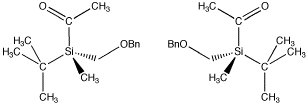4 つの基が付いた原子は、四面体の形状を取ることもあります。 この形状は、中心原子が少し小さい場合によく起こります。
正方形の平面化合物とは異なり、単純四面体化合物には、シスとトランスの異性体のようなものは存在しません。 つまり、2つの基を正四面体上で互いに反対や横になるように配置することはできない。
Dichlorodimethylsilane は、シリコーン ポリマーを作るのに使用できる化合物です。 プラチンと同様、中心原子に2つずつの基が結合している。 しかし、中心トムは四面体である。 There is only one way to arrange these four groups.

Figure SC3.1. A tetrahedral atom with two different types of groups attached, (CH3)2SiCl2.
However, if four different groups are attached to a tetrahedral atom, the four groups can be arranged in two possible ways. The two compounds that result are mirror images of each other. These two isomers are called enantiomers.

Figure SC3.2. A pair of enantiomers. The (-) enantiomer is on the left and the (+) enantiomer is on the right.
- エナンチオマーとは、接続性は全く同じだが、立体形状が正反対の化合物のペアのことです。
- Enantiomers are mirror images of each other.
接続性が全く同じで、互いに鏡像であるが同じではない 2 つの化合物をエナンチオマーと呼びます。 より一般的なエナンチオマーの定義は、その鏡像に重ね合わせることができないことである。
- これらのペアが存在する化合物は「キラル」と呼ばれます。
- 「キラル」はギリシャ語の「手」に由来しています。
また、鏡面をもたない分子、つまり同じものと反対のものに分けられない分子をエナンチオマーと定義することが、対称性の数学である群論を用いて示されることがあります。
- Enantiomers contain no mirror plane.
- Enantiomers does not contain two equal and opposite halves.
シス異性体やトランス異性体と異なり、2 つのエナンチオマーは同じ物理的特性を持ちます。 ほぼ同じであるが、互いに鏡像である 2 つの化合物は、まったく同じ種類の分子間引力を持つので、物理的特性が同じであることは驚くことではありません。
- Enantiomers も立体異性体の一例です。
- 2 つのエナンチオマーは、光学回転を除いて、同一の物理特性を持ちます。
光学回転は、平面偏光と物質の相互作用を含みます。 材料が対称的でない場合、それを通過する光は回転します。 つまり、光を構成する波が材料に入るときに1つの方向に振動している場合、材料から出るときに別の方向に振動するようにわずかに傾いているのです。
- 2 つのエナンチオマーは、平面偏光に対して等しいが反対の回転効果を持ちます。
- (+) エナンチオマーは光を時計方向に回転させます。
- (-) enantiomers rotate light in a counterclockwise direction.
For example, in the chiral silicon compound shown above, the (+) enantiomer rotates plane-polarized light in a clockwise direction. It has a “standard optical rotation” of = +12 (+/-2)o. The (-) enantiomer rotates plane-polarized light in a counterclockwise direction. It has a “standard optical rotation” of = -9.9 (+/-2)o.
Problem SC3.1.
A certain compound exists in two forms; enantiomer A and enantiomer B. Enantiomer A has a molecular weight of 126 g/mol, a density of 0.995 g/mL, an optical rotation of = 26o, a melting point of 65 oC, a boiling point of 225 oC, and an odour of citrus fruit. What can you say about the corresponding properties of enantiomer B?
Contributors
-
Chris P Schaller, Ph.D., (College of Saint Benedict / Saint John’s University)